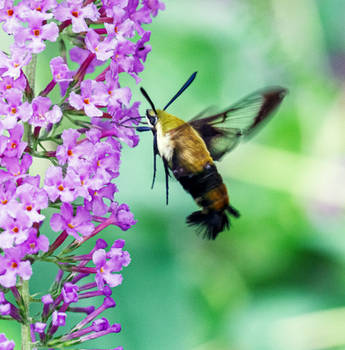ShopDreamUp AI ArtDreamUp
Deviation Actions
Suggested Deviants
Suggested Collections
You Might Like…
Description
This is a Hummingbird Moth or Bumblebee Moth Hemaris diffinis  I have been dying to catch one of these guys
I have been dying to catch one of these guys Let me tell you there name is quite appropriate as they are super fast just like their namesake the Hummingbird. I have tried catching these guys before but, with my standard 18-55mm lens it was almost impossible for me to get close enough much less focus on them
Let me tell you there name is quite appropriate as they are super fast just like their namesake the Hummingbird. I have tried catching these guys before but, with my standard 18-55mm lens it was almost impossible for me to get close enough much less focus on them Well, I had given up on getting a pic of one this year then low and behold this guy showed up in my garden and after I had gotten my 70-300mm lens
Well, I had given up on getting a pic of one this year then low and behold this guy showed up in my garden and after I had gotten my 70-300mm lens Somebody must really like me to have given me this special visitor
Somebody must really like me to have given me this special visitor He spent awhile in my flowers and I had a blast trying to capture him/her with my camera....
He spent awhile in my flowers and I had a blast trying to capture him/her with my camera....
--------------------------------------------
Hummingbird Moth
Alternate name: Hummingbird Moth
Family: Sphingidae, Sphinx Moths view all from this family
Description: 1 1/2 - 2" (37-50mm). Quite variable, both geographically and seasonally. Wings basically clear, with dark veins, bases, and edges. Thorax golden-brown to dark greenish-brown. Abdomen dark with 1-2 yellow segments just before the terminal end.
Similar Species: The four North American species of clearwing moths are very similar. The most widespread and common, along with the present species, is the Hummingbird Moth (Hemaris thysbe) which has wider dark borders on its wings.
Life Cycle: Caterpillar pale green on back, darker green on sides, with numerous white flecks. Horn bright yellow at base and blue-black at the tip. Pale blue-ringed spiracles along side of body very evident. Pupa 1" and brown. Pupates in cocoon on the ground. Host plants include Snowberry, Coralberry, viburnums, Blue Dogbane. Pupates in cocoon on the ground .
Flight: Two broods, March-Sept. depending upon latitude
Habitat: Forest edges, meadows, gardens, brushy fields.
Range: British Columbia to Nova Scotia and south through the U.S.
Discussion: Flies by day. Hovers on rapidly beating wings at garden flowers; often mistaken for small hummingbird or large bee. Very interestingly, this species has all dark wings after emerging from the pupa. The transparent patches appear after the moth has flown for a while, dislodging the appropriate scales with its rapid flight.
--------------------------------------------
Hummingbird Moth
Alternate name: Hummingbird Moth
Family: Sphingidae, Sphinx Moths view all from this family
Description: 1 1/2 - 2" (37-50mm). Quite variable, both geographically and seasonally. Wings basically clear, with dark veins, bases, and edges. Thorax golden-brown to dark greenish-brown. Abdomen dark with 1-2 yellow segments just before the terminal end.
Similar Species: The four North American species of clearwing moths are very similar. The most widespread and common, along with the present species, is the Hummingbird Moth (Hemaris thysbe) which has wider dark borders on its wings.
Life Cycle: Caterpillar pale green on back, darker green on sides, with numerous white flecks. Horn bright yellow at base and blue-black at the tip. Pale blue-ringed spiracles along side of body very evident. Pupa 1" and brown. Pupates in cocoon on the ground. Host plants include Snowberry, Coralberry, viburnums, Blue Dogbane. Pupates in cocoon on the ground .
Flight: Two broods, March-Sept. depending upon latitude
Habitat: Forest edges, meadows, gardens, brushy fields.
Range: British Columbia to Nova Scotia and south through the U.S.
Discussion: Flies by day. Hovers on rapidly beating wings at garden flowers; often mistaken for small hummingbird or large bee. Very interestingly, this species has all dark wings after emerging from the pupa. The transparent patches appear after the moth has flown for a while, dislodging the appropriate scales with its rapid flight.
Image size
900x604px 313.89 KB
Make
Canon
Model
Canon EOS DIGITAL REBEL
Shutter Speed
1/800 second
Aperture
F/4.5
Focal Length
176 mm
ISO Speed
400
Date Taken
Jun 2, 2006, 11:39:42 AM
© 2006 - 2024 GeodeLady
Comments86
Join the community to add your comment. Already a deviant? Log In
My husband and I had never seen one of these before yesterday. Quite simply, it is the most beautiful insect I've ever seen. The one yesterday had lime green color shoulders, and some red, so it really did look like a ruby-throated hummingbird, only 1/3 the size. Of course, the antennae and six legs made it apparent this was no bird! The dark brown lace wings are poetically beautiful. It had flown by us about a half-hour before we saw it among the petunias; because of its size and see-thru wings, we'd wondered if it were a cicada, but the flash of bright green made us think, 'No..' This was in the far south suburbs of Chicago, Illinois, very near large forest preserves, so that explains why we'd never seen one before, as we are lifelong city dwellers. What a beautiful creature. Thank you for your perseverance in getting such a great shot of this one--well done!


































